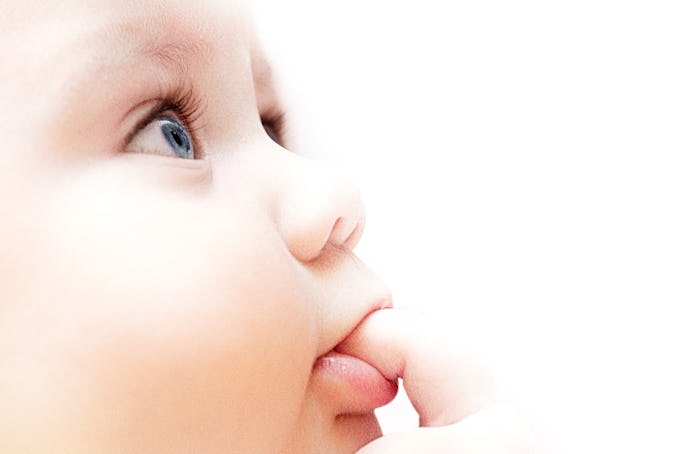Life
Here's Why Some Babies Have Watery Eyes All The Time, Even When They're Not Crying
You have a new baby and can't stop staring at them. They are gushingly adorable and absolutely perfect. Except you look a little closer and notice something's amiss: their beautiful eyes look like they are a little watery. Or they wake up after a nap and you find some crusty stuff in the corner of their eyes. Is something terribly wrong? Why do babies have watery eyes when they're not crying, and what should you do about it, because you worry that if you don't, you may be ruining their vision for life.
While it's possible that pollen allergies or an eye infection are causing their watery eyes, the most likely culprit is a blocked tear duct. Despite sounding like they do, tear ducts do not produce tears, they carry the tears away. The Mayo Clinic likened it to how a storm drain carries away rainwater. "Tears normally drain into your nose through tiny openings (puncta) in the inner part of the lids near the nose," according to the Mayo Clinic staff. "In babies, the tear duct may not be fully open and functioning for the first several months of life."
Dr. William Sears, a noted pediatrician, told Parenting that almost half the babies in his practice have blocked tear ducts. While some newborns will show signs of this in the first few weeks of life, Dr. Michelle Bischoff, a pediatrician in Canada, explained to Today's Parent that sometimes you might not see the effects of the blocked ducts until weeks or months after birth. Some babies may have this problem in one eye, but others might experience it in both, as Dr. Stephanie Liu, a family physician in Canada, said in the same Today's Parent article.
Does this mean you have to run straight to the doctor for fear of damaging their vision for life? Absolutely not. The situation sometimes resolves itself, but it could be helpful and give you some peace of mind to discuss it with your baby's pediatrician. There are in-home things you can do for your baby in the meantime. Dr. Sears suggested to Parenting that parents take a clean, soft cloth and gently wipe away the discharge. Then, use a well-scrubbed fingertip to massage the corners of the eyes that is closest to their nose, where the tear ducts converge, "moving your fingertip in a semi-circle from the corner of the eye inward toward the nose," according to Dr. Sears. He recommended repeating this five or 10 strokes, six times a day and making it a part of your daily routine. Dr. Liu warned that during the massage, you might see some gunk come out of your babies nose, but this is perfectly normal and nothing alarming.
Some moms recommend squirting breastmilk in the baby's eye to open the ducts. Is this scientifically proven to be effective or just an old wives tale? La Leche League of Canada says there's no harm in doing it, though they haven't really seen evidence that it works. There are a few studies that show a slight reduction in bacteria with the application of breastmilk, but nothing to show it'll open blocked ducts. Dr. Sears is more encouraging and feels that there is an antibiotic-like effect from the breastmilk, because, "Each drop of your milk contains millions of infection-fighting white blood cells and natural antibacterial substances."
There's still a chance the watery eyes are a product of pollen or other airborne allergies or conjunctivitis, although with both of these you may see redness in addition to the watery eyes. If you think this could be the case, it might be beneficial to talk to your child's doctor to see if they think further testing would help. There could also be a ridiculously simple reason for the excessive tearing — a foreign object such as an eyelash could be irritating the baby's eye, Mom Junction mentioned.
The good news is that all of these problems are temporary, and their tear ducts should kick into gear in time. So keep looking into those adorable little baby eyes and know that a little watery discharge here and there is normal.
